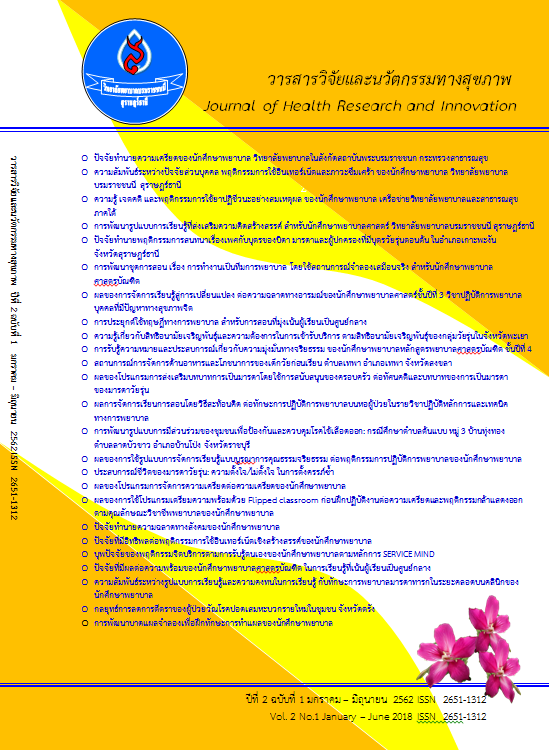กลยุทธ์การลดการตีตราของผู้ป่วยวัณโรคปอดเสมหะบวกรายใหม่ในชุมชน จังหวัดตรัง
คำสำคัญ:
วัณโรค, พี่เลี้ยงกำกับการกินยา, การตีตรา, การสร้างเสริมพลังอำนาจบทคัดย่อ
การวิจัยเชิงคุณภาพโดยใช้วิธีการศึกษาแบบปรากฏการณ์วิทยานี้ มีวัตถุประสงค์เพื่อศึกษาปรากฎการณ์เกี่ยวกับความหมายและลักษณะของการตีตราผู้ป่วยวัณโรคปอด ที่มีผลการตรวจเสมหะเป็นบวกรายใหม่ และศึกษากลยุทธ์การลดการตีตราของผู้ป่วยวัณโรคปอดในชุมชน จังหวัดตรัง กลุ่มตัวอย่าง ประกอบด้วย ผู้รับผิดชอบงานวัณโรคระดับตำบลจำนวน 6 คน ผู้กำกับการกินยาผู้ป่วยวัณโรคจำนวน 6 คน และผู้ป่วยวัณโรคเสมหะบวกรายใหม่จำนวน 6 คน การเก็บรวบรวมข้อมูลประกอบด้วยการสัมภาษณ์เชิงลึก การสังเกต การบันทึกเทป และการจดบันทึกภาคสนาม วิเคราะห์ข้อมูลด้วยการวิเคราะห์เชิงเนื้อหา
ผลการวิจัยพบว่า การตีตราของผู้ป่วยวัณโรคปอด หมายถึง ความรู้สึก ถูกรังเกียจ ไม่อยากเข้าใกล้จากคนในชุมชน ซึ่งความกลัวการถูกตีตรานั้นเป็นอุปสรรคสำคัญในการเปิดเผยตนเองของผู้ป่วย ซึ่งกลยุทธ์ที่ใช้เพื่อลดปัญหาการตีตราผู้ป่วย ประกอบด้วยการเสริมสร้างพลังอำนาจทั้งผู้ป่วยและพี่เลี้ยง การกำกับการกินยา การปกปิดข้อมูลของผู้ป่วยไว้เป็นความลับ การให้ความรู้แก่พี่เลี้ยงกำกับการกินยาเพื่อให้มีความมั่นใจในการให้คำแนะนำผู้ป่วย และการมีส่วนร่วมของภาคีเครือข่ายชุมชน เพื่อช่วยส่งเสริมให้ผู้ป่วยวัณโรคมีทัศนคติที่ดี มีกำลังใจ และมีความตระหนักถึงความสำคัญในการกินยาอย่างต่อเนื่องจนครบตามแผนการรักษา
เอกสารอ้างอิง
Bureau of Tuberculosis, Ministry of Public Health, Thailand. (2018). National Tuberculosis Control Programme Guideline, Thailand, 2018. Bangkok: Aksorn Graphic and Design Publication Limited Partnership.
Choowong, J., Tillgren, P., & Söderbäck, M. (2016)., Thai District Leaders’ Perceptions of Managing the Direct Observation Treatment Program in Trang Province, Thailand. BioMed Central Public Health, 16:653, DOI 10.1186/s12889-016-3341-1.
Choowong, J. Tillgren, P., & Söderbäck, M. (2017). Thai People Living with Tuberculosis and How they Adhere to Treatment: A Grounded Theory Study. Nursing & Health Sciences, 1-8, DOI: 10.1111/nhs.12362.
Escott, S., & Walley, J. (2005). Listening to those on the frontline: lessons for community-based tuberculosis programmes from a qualitative study in Swaziland. Social Science & medicine, 61(8), 1701-1710.
Goffman, E. (1963). Stigma: Note on the Management of Spoiled Identity. New Jersey: Prentice-Hall.
Graneheim, H. U., & Lundman, B. (2004). Qualitative content analysis in nursing research: concepts, procedures and measures to achieve trustworthiness. Nurse Education Today, 24, 105-112.
Jin, J., Sklar, G. E., Sen, Oh. V. M, & Li, S. C. (2008). Factors Affecting Therapeutic Compliance: A Review from the Participant's Perspective. Therapeutics and Clinical Risk Management, 4(1), 269- 286.
Lertmaharit, S., Kamol-Ratankul, P., Sawert, H., Jittimanee, S., & Wangmanee, S. (2005). Factors associated with compliance among tuberculosis participants in Thailand. Journal of the Medical Association of Thailand, 88(4), S149-S156.
Lewis, C. P. & Newel, J. N. (2009). Improving tuberculosis care in low income countries–a qualitative study of patients’ understanding of “patient support” in Nepal. Biomed Central Public Health, 9: 190, 1-8. doi: 10.1186/ 1471-2458-9-190
Macq, J., Torfoss, T., & Getahun, H. (2007). Patient empowerment in tuberculosis control: reflecting on past documented experiences. Tropical Medicine & International Health, 12(7), 873–885.
Marton, F., & Booth, S. (1997). Learning and Awareness. Mahwah, New Jersey, USA: Lawrence Erlbaum Ass. Marton, F., & Booth, S. (1997). Learning and Awareness. Mahwah, New Jersey, USA: Lawrence Erlbaum Ass.
Ngamvithayapong-Yanai, J., Winkvist, A., Luangjina, S., & Diwan, V. (2005). If We Have to Die, We Just Die: Challenges and Opportunities for Tuberculosis and HIV/AIDS Prevention and Care in Northern Thailand. Qualitative Health Research, 15(9), 1164-1179. DOI: 10.1177/1049732305281616
Open Society Institute Public Health Program. (2006). Civil Society Perspectives on TB Policy in Bangladesh, Brazil, Nigeria, Tanzania and Thailand. New York: Open Society Institute.
Pandit, N., & Choudhary, S. K. (2006). A Study of Treatment Compliance in Directly Observed Therapy for Tuberculosis. Indian Journal of Community Medicine, 31(4), 241-243.
Pungrassami, P., Johnsen, P., Chonguvivatwong, V., & Olsen, J. (2002). Has Directly Observed Treatment Improved Outcome for Participants with Tuberculosis in Southern Thailand? Tropical Medicine & International Health, 7(3), 271-279.
Sengupta, S., Pungrassami, P., & Balthip, Q. (2006). Social Impact of Tuberculosis in Southern Thailand: Views from Participants, Care Providers and the Community. International Journal of Tuberculosis and Lung Disease, 10(9), 1008–1012.
Stutterheim, S.E., Pryor, J.B., Bos, A.E.R., Hoogendijk, R., Muris, P., & Schaalma, H.P. (2007). HIV-related stigma and psychological distress: the harmful effects of specific stigma manifestations in various social settings. Department of Work and Social Psychology. Maastricht University. Netherlands.
Suwankeeree, W., & Picheansathian, W. (2014). Strategies to Promote Adherence to Treatment by Pulmonary Tuberculosis Patients: a Systematic Review. International Journal of Evidence-Based Healthcare, 12(1), 3-16. DOI: 10.1097/01.XEB.0000444614.17658.46
World Health Organization. (2018). Global tuberculosis report 2018. France: World Health Organization, WHO/CDS/TB/2018
ดาวน์โหลด
เผยแพร่แล้ว
รูปแบบการอ้างอิง
ฉบับ
ประเภทบทความ
สัญญาอนุญาต
บทความที่ได้รับการตีพิมพ์เป็นลิขสิทธิ์ของวารสารวิทยาลัยพยาบาลบรมราชชนนี สุราษฎร์ธานี
ข้อความที่ปรากฏในบทความแต่ละเรื่องในวารสารวิชาการนี้เป็นความคิดเห็นส่วนตัวของผู้เขียนแต่ละท่านไม่เกี่ยวข้องกับวิทยาลัยพยาบาลบรมราชชนนี สุราษฎร์ธานี และคณาจารย์ท่านอื่นๆในวิทยาลัยฯ แต่อย่างใด ความรับผิดชอบองค์ประกอบทั้งหมดของบทความแต่ละเรื่องเป็นของผู้เขียนแต่ละท่าน หากมีความผิดพลาดใดๆ ผู้เขียนแต่ละท่านจะรับผิดชอบบทความของตนเองแต่ผู้เดียว



